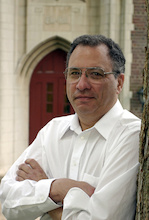Simon Levin - Uncovering Nature’s Hidden Patterns
Infectious diseases, economics and wildebeest herds might not seem to have much in common, but they all provide fodder for world-renowned researcher Simon Levin, Ph.D. ’64, Mathematics. These are but a few of the complex systems that Levin has analyzed throughout his 46-year career in academia, seeking the patterns governing their operations. A pioneer in theoretical ecology, Levin, recipient of the 2011 CMNS Distinguished Alumnus Award, currently serves as the George M. Moffett Professor of Biology and the director of the Center for BioComplexity at Princeton University.
Much of Levin’s research marries mathematics with biology, yielding new understanding about natural phenomena. In the 1970s, Levin was instrumental in launching the field of spatial ecology, which uses statistical analysis to examine natural patterns of dispersal and movement across geographic areas, looking at everything from seed dispersal to the movement of wildebeest herds. His work on understanding the dynamics of ecosystems, from marine systems to forests, has been instrumental in building a baseline measurement and predictive tools for environmental change, including climate change.
Levin is most famous for his work on complex adaptive systems and their components that operate on different scales yet interact and react to both the environment and to one another. For example, as your eyes scan this article, your neurons and synapses work together on the smaller, cellular scale. Using mathematics, Levin showed how to integrate a system’s different scales, quantifying how the parts interact, connect and provide feedback to one another. His 1992 landmark paper on this topic, “The Problem of Pattern and Scale in Ecology,” was the most cited paper in the field of ecology and environment published in the 1990s, with more than 3,000 citations to date.
Novel Applications for Mathematics
Behind Levin’s mathematical genius is the solid grounding he received at the university. “I wanted to specialize in applied mathematics and Maryland was—as it is today—a leader in the field,” says Levin, who completed his doctoral studies at Maryland’s Institute for Fluid Dynamics and Applied Mathematics, the predecessor of today’s Institute for Physical Science and Technology.
Levin’s world-class education at Maryland opened his eyes to a host of areas to which mathematics could be applied, including biology. “Institute Director Monroe Martin encouraged me to follow my own interests, even though they were outside the traditional areas of mathematics,” Levin appreciatively recalls.
Motivated by his love for both applied mathematics and his fiancée, who insisted he complete his degree before they wed, Levin earned his doctorate in three years. (Forty-seven years later, Levin and his wife Carole have two children and four grandchildren.) Through a postdoctoral fellowship at the University of California, Berkeley, Levin applied mathematics to physiology problems, but soon shifted his focus to a different branch of biology that became his lifelong passion— ecology. He joined Cornell University one year later as an assistant professor of mathematics, with a focus on ecological problems— a rare approach at the time. “In 1965 most mathematics departments were not ready for a real commitment to applications, especially biology,” says Levin. At Cornell, however, Levin found ecologists eager to collaborate. He soon became a member of the Division of Biological Sciences and in 1974 was appointed chair of its Ecology and Systematics Section.
Growing up in Baltimore, Levin loved the outdoors, taking family hikes every weekend and spending summers swimming and canoeing. His appreciation for nature gained new meaning in the 1960s with the burgeoning environmental movement. “There was increasing awareness of Earth’s finite resources,” says Levin. “I became more and more concerned about environmental problems, and was driven to do work to solve the problems of humanity.”
Blending Economics & Ecology
In 1992, following a 27-year career at Cornell, Levin joined Princeton University’s Department of Ecology and Evolutionary Biology. While he still explores ecological issues, Levin has expanded his scope to also look at the patterns behind economic and social systems. His current research examines collective decision-making in animal populations, such as why fish school together and how birds flock. He applies his findings to deepen the understanding of collective decision-making in human societies. “Economic and ecological systems are very similar,” explains Levin. “They’re both made up of individual agents pursuing their own selfish agendas. It doesn’t matter whether you’re talking about humans or organisms utilizing limited resources.”
Levin has received a string of awards for his accomplishments, including the MacArthur Award from the Ecological Society of America and the Kyoto Prize for Basic Science, but what makes him proudest are the successes of the students he has mentored through the years. As he teaches the next generation of theoretical ecologists, he cites his professors at Maryland as role models. “I admired their enthusiasm for communicating mathematics and their ability to help foster my passions and interests,” says Levin. “I strive every day to bring that same enthusiasm to my students.”



